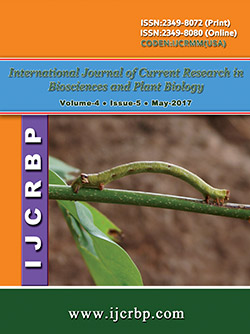 |
Online ISSN : 2349-8080 Issues : 12 per year Publisher : Excellent Publishers Email : editorinchiefijcrbp@gmail.com |
2New Zealand Institute of Plant and Food Research Limited, Private Mail Bag 92169, Auckland Mail Centre, New Zealand
Postharvest rots are a significant limitation to the storage life of white fleshed dragon fruit, this paper aimed to identify the main pathogens associated with postharvest diseases in the Mekong delta region, to identify the origins of infections, and to investigate the use of heat treatments for postharvest rot control. Dragon fruit were stored at 0°C, 5°C and 10°C for 26 days followed by 3 days shelf life at 20°C. Other fruit were held at 20°C for 7 days as a non-stored control. The main fungi associated with postharvest rots were Alternaria alternata, Bipolaris cactivora, Colletotrichum truncatum, Fusarium dimerum, Fusarium equiseti and Rhizopus stolonifer. Skin pieces plated out from freshly harvested surface sterilised fruit yielded C. truncatum, F. dimerum, F. equiseti, A. alternata, and B. cactivora. Surface swabs from fruit in the field yielded A. alternata and Fusarium sp. The study showed that, except for those caused by R. stolonifer, all postharvest rots of dragon fruit have their origin either as latent infections in the field or as surface-borne spores. Many of the rot pathogens could grow at low temperatures and surface-borne Fusarium and Alternaria species were able to infect the fruit during storage. To test the effect of hot water treatments (HWTs) on postharvest rots, freshly harvested fruit were immersed at 49, 51, 53, and 55°C for two or three minutes, stored at 5-6°C for 28 days and 3 days shelf life. HWTs at 49°C and 51°C for two or three minutes both completely inhibited rots during storage, and after the shelf-life, significantly fewer rots were observed than other HWTs and the untreated control. The 49 and 51°C HWTs also showed the least weight loss no damage to bracts, and no effect on titratable acidity, total soluble solids, fruit firmness, or flesh or skin colour. Current gaps in knowledge of postharvest rots and research strategies to address them are outlined in the paper.
